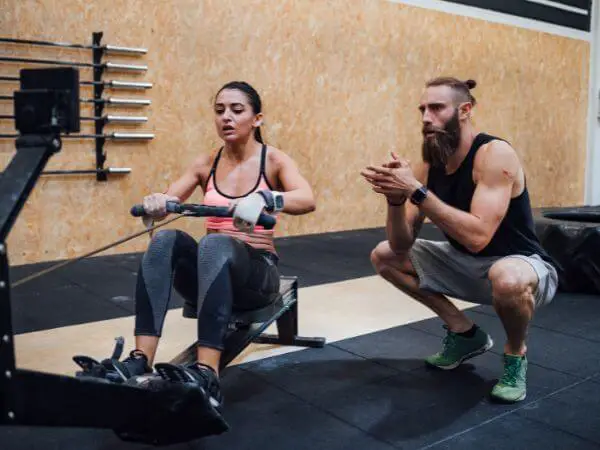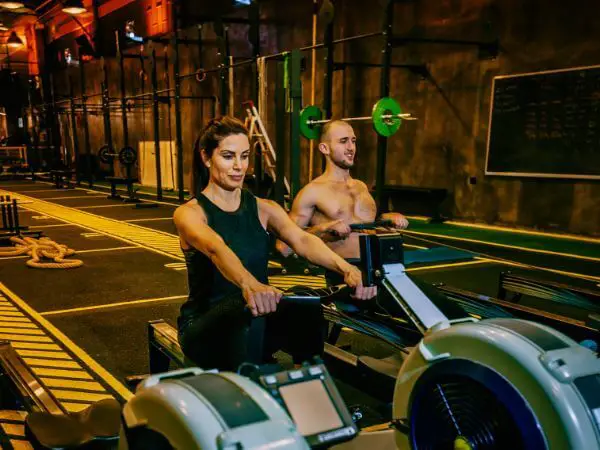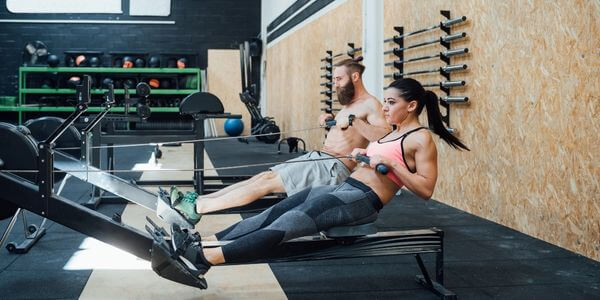Want to know which muscles are worked the most when you row?
Well, that’s the upper body muscles. These muscles include the biceps, triceps, and pectorals. The quadriceps and hamstrings are used to power the stroke, while the gluteus maximus and lower back work hard to keep you stable.
Using a rowing machine, you can target all these muscles for a well-rounded workout. Not only will you see results in muscle tone, but you’ll also get a fantastic cardio workout that torches calories.
Read more about how to use a rowing machine to get fit below.
Table of Contents
Biceps
When you use a rowing machine, your biceps are engaged in two ways.
First, as you grip the machine’s handle, your biceps muscles contract to help keep your hand in place. Second, as you pull the handle towards your chest, your biceps muscles help bend your elbow.
The rowing motion also works other muscles in your arms, including your triceps and shoulder muscles. However, your biceps are primarily responsible for providing the force needed to move the handle.
What you get:
- You’ll have toned arms.
- You’ll be able to row faster.
- Impress your friends with your curvy biceps.
Triceps

When you row, your arms are extended in front of you, and your elbows are bent. This position puts your triceps in a prime position to do the work. As you row, your arms straighten out, contracting your triceps. The resistance of the rowing machine provides resistance against which your muscles can work, making them stronger and more defined.
What you get:
- You’ll have toned arms in no time.
- Finally, be able to wear tank tops with confidence.
- Get compliments from your friends on your amazing arms.
Forearm Muscles
When you grip the handle and begin to row, your forearm muscles are engaged to keep the handle from slipping. As you continue to row, these muscles must work even harder to maintain a firm grip.
The rowing motion also works the extensor muscles on the back of your forearm. These muscles help to straighten your wrist and keep your hand from cramping.
As a result, a rowing machine provides a well-rounded workout for your forearm muscles.
What you get:
- Increased strength
- Stronger wrists and bones
- You can carry all your groceries in one go
Shoulder Muscles
Rowing is an excellent way to work your shoulder muscles because it involves a wide range of motion.
As you row, your shoulder muscles are responsible for pulling the handle towards your body. This movement requires a great deal of strength and stability, leading to significant gains in muscular endurance.
Plus, the rowing machine provides resistance that challenges your muscles and helps you achieve greater results.
What you get:
- Toned, sexy shoulders
- Fewer tension headaches
- Less risk of a shoulder injury
Chest Muscles

When you pull on the rowing machine’s handle, you use your chest muscles to drive the handle back towards your body. This action works your chest muscles, as well as the muscles in your shoulders and arms.
Rowing machines also provide a natural resistance that helps to build muscle strength. Over time, this resistance will tone and build your chest muscles.
What you get:
- Sculpt your pectorals.
- Decrease unwanted fat deposits in the area.
- Reduce sagginess.
Read more: 7 Best Exercise Machines for Bigger Chest Muscles
Upper Back
Your arms move back and forth while your legs drive the seat forward when you row. This movement engages the muscles in your back, shoulders, and arms. The resistance of the rowing machine helps strengthen and tone these muscles.
What you get:
- Better posture
- Sexier lats
- Fewer backaches and tension headaches
Core (Abs and Lower Back)
Rowing is an excellent way to work your lower back muscles. When you row, your legs push against the footrests while your arms pull on the handle. This simple movement activates many muscles in your back, including the erector spinae and latissimus dorsi.
Rowing also works the abdominal muscles (rectus abdominis and obliques). As a result, rowing is an effective exercise for strengthening your entire core.
What you get:
- Slimmer abs and defined obliques
- Better posture
- Fewer backaches
- Look and feel more confident
Glutes
When you row, your legs are extended in front of you, and your back is straight. This position puts your glutes in a great position to work.
The rowing motion works your glutes through a full range of motion, from the top of the stroke where your legs are almost fully extended to the bottom of the stroke where your legs are bent at the knees.
Therefore, you can get an effective glute workout on a rowing machine.
What you get:
- Reduce the risk for sciatica pain or backaches.
- Surprise yourself with your newfound bootyliciousness.
- Feel more confident in your skintight jeans.
Read more: 7 Best Exercise Machines for Bigger Glutes
Hamstrings

Hamstring muscles are located on the back of the thigh and are responsible for knee and hip extension.
As you row, the flywheel turns, providing resistance against which you must pull. This resistance activates your hamstring muscles as they work to extend your legs.
What you get:
- Powerful legs
- Increased calorie burn because hamstrings are large muscles that expend a lot of energy
Quads
When using a rowing machine, your quads work to push against the resistance of the pedals. This type of resistance is called concentric resistance, and it is created when your muscles shorten as they contract.
For your quads to work against the resistance, they must generate enough force to overcome it. The amount of force that your muscles can generate is determined by their size and strength.
Therefore, a rowing machine can help increase your quads’ size and strength.
What you get:
- Ripped quads
- Reduced overall body fat percentage and harmful cholesterol levels
Calves
When you row, your calves must push against the footplates to slide on the rowing machine. This resistance increases the workload on your calf muscles, causing them to grow stronger and more defined.
What you get:
- You’ll have strong calves.
- You’ll improve your peripheral blood circulation.
- You’ll be able to run a marathon.
- You’ll be able to wear heels without pain.
Wrap Up. How to Get Better Results
Rowing is an effective way to get a full-body workout. However, getting the most out of your rowing machine requires more than just hopping on and starting to row.
Here are some tips to help you get better results:
- Make sure that you’re using the correct resistance. If the resistance is too low, you won’t be challenged enough and won’t see results. On the other hand, if the resistance is too high, you’ll quickly burn out and be unable to maintain good form.
- Focus on your form. Make sure that you’re sitting up straight and engaging your core muscles. Also, drive through your legs and not just your arms.
- Don’t forget to warm up before you row and cool down afterwards. A proper warm-up will help prevent injuries and ensure your muscles are ready to work hard. Cooling down will help your muscles recover and prevent stiffness.
Following these tips will help you get better results from your rowing machine workouts. So what are you waiting for? Row like an Olympian and feel the burn.
- 7 Exercises for Pregnant Women in the First Trimester: Safe and Effective - January 30, 2025
- Our equipment recommendations - October 30, 2024
- Here’s What Doing Cardio Every Day Does To Your Body - August 21, 2024

